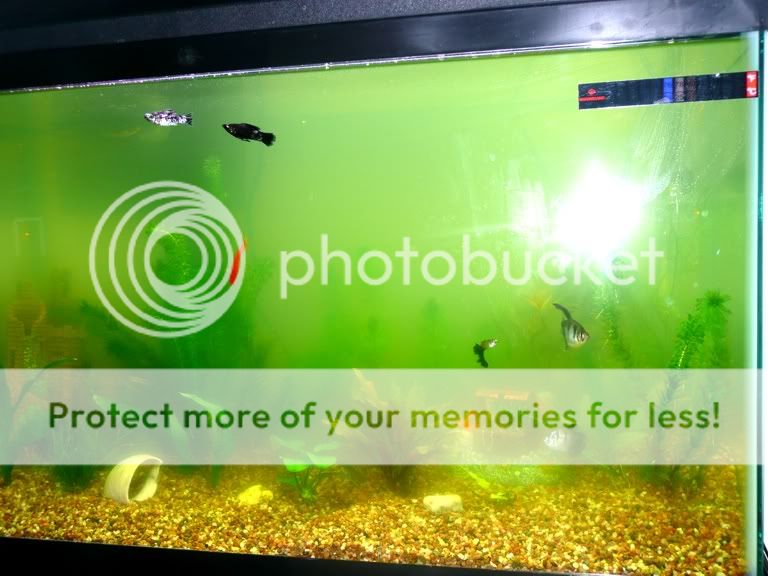aquaidoka
New Member
Dear all, can we please have a fresh insight in the problem I put here before?
My aquarium is cloudy for about 1 month already. Test results are:
(1) Ammonia and (2) nitrite tests are 0 ppm, so there is no cycling.
(3) Nitrate and (4) phosphate tests are 0 ppm or very close to it (significantly less than 5 ppm for nitrate and 0.25 ppm for phosphate) -- so if it is an alga bloom, what do algae consume?
(5) pH 7.2
(6) KH 4 deg (raised from 2 deg by baking soda)
(7) GH 4 deg
(8) CO2 calculated to be 7-8 ppm (a bit low from DIY contraption - have to improve it a bit)
Used tap water contains no phosphates, has KH 2, and GH 3
To avoid questions about the validity of the tests, I would dare to assert humbly that I am a professional chemist for twenty years and calibrated everything in used standard aquarium liquid tests (all tests are from API except for phosphate, which is Nutrafin).
I have 29 Gal aquairium for about three month stocked by young fish all near or below 2 inches (2 pearl gouramis, 3 neon tetra, 2 black skirth tetra, 2 guppies, 1 swordtail, 2 otos, 1 false SAE, 2 dalmatian mollies). Aquairium is moderately planted, lit with 65+18 W lamps for 8-10 hours per day, aerated when lights are off, yeast-CO2-purged with lights on, filtered by AquateTech 20-40 with biosupport as Bio Modules from Imaging, mechanical and activated carbon filter, and yesterday put their phosphate cleaning filter (to compete with algae if they consume all appearing phosphates). Fish is fed one time per two days with amount they can eat in 2-3 minutes. Fish behavior is calm with no signs of stress.
Why my aquarium is cloudy?!
The image of my aquairium today follows (not a high quality but this one is most close to the reality):

My aquarium is cloudy for about 1 month already. Test results are:
(1) Ammonia and (2) nitrite tests are 0 ppm, so there is no cycling.
(3) Nitrate and (4) phosphate tests are 0 ppm or very close to it (significantly less than 5 ppm for nitrate and 0.25 ppm for phosphate) -- so if it is an alga bloom, what do algae consume?
(5) pH 7.2
(6) KH 4 deg (raised from 2 deg by baking soda)
(7) GH 4 deg
(8) CO2 calculated to be 7-8 ppm (a bit low from DIY contraption - have to improve it a bit)
Used tap water contains no phosphates, has KH 2, and GH 3
To avoid questions about the validity of the tests, I would dare to assert humbly that I am a professional chemist for twenty years and calibrated everything in used standard aquarium liquid tests (all tests are from API except for phosphate, which is Nutrafin).
I have 29 Gal aquairium for about three month stocked by young fish all near or below 2 inches (2 pearl gouramis, 3 neon tetra, 2 black skirth tetra, 2 guppies, 1 swordtail, 2 otos, 1 false SAE, 2 dalmatian mollies). Aquairium is moderately planted, lit with 65+18 W lamps for 8-10 hours per day, aerated when lights are off, yeast-CO2-purged with lights on, filtered by AquateTech 20-40 with biosupport as Bio Modules from Imaging, mechanical and activated carbon filter, and yesterday put their phosphate cleaning filter (to compete with algae if they consume all appearing phosphates). Fish is fed one time per two days with amount they can eat in 2-3 minutes. Fish behavior is calm with no signs of stress.
Why my aquarium is cloudy?!
The image of my aquairium today follows (not a high quality but this one is most close to the reality):



 /www.fishforums.net/index.php?/topic/299827-why-we-should-not-fishless-cycle-planted-tanks/
/www.fishforums.net/index.php?/topic/299827-why-we-should-not-fishless-cycle-planted-tanks/

 we are trying to keep our entertainment alive watching these wonderful contraptions he is building!)
we are trying to keep our entertainment alive watching these wonderful contraptions he is building!) Ok, I can live with that since my aquarium is clarifying!
Ok, I can live with that since my aquarium is clarifying!